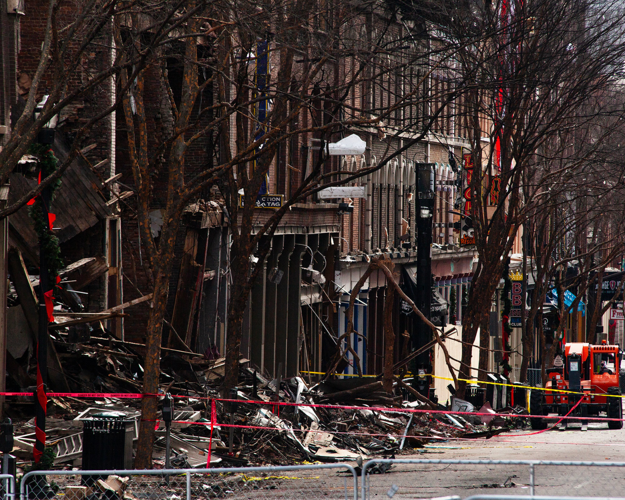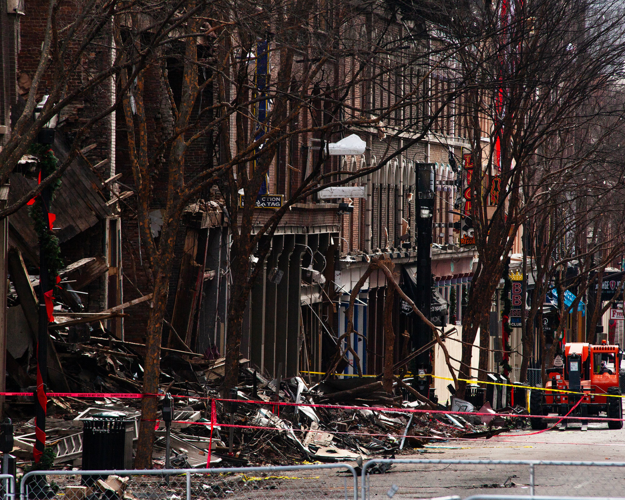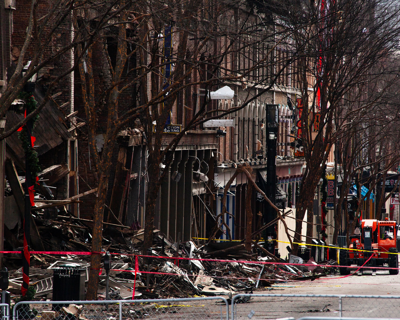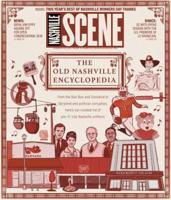
Second Avenue in January
In the days following the Christmas bombing on Second Avenue, Metro Nashville Codes Administration officials were concerned that many, if not all, of the affected buildings would have to be demolished. Such a move would erase from the cityscape what was Nashville’s first major historic preservation success story.
But as cleanup progressed and codes officials and engineers were able to get a clearer look at the damage, the outlook became rosier. Codes director Bill Herbert said a look inside with his department’s chief engineer made it clear “that every one of these buildings can be rehabilitated.”
That’s not a universal opinion, however. One property owner who owns five of the affected buildings brought in his own engineer, who said some of them will have to be demolished. Because the buildings have party walls — that is, shared exterior walls — there is concern that the demolition of one will force the demolition of the next, and so on in a domino effect.
For now, the buildings are shored up while cleanup continues and property owners and city officials decide their fate.
The Metro Historical Commission and its sister Historical Zoning Commission are among the government entities that can provide technical assistance for repairs and restoration of damaged historical properties. Owners of income-producing buildings on the National Register of Historic Places are eligible for a 20 percent federal tax credit for substantial rehabilitations.
Stephen McNair — owner of Mobile, Ala.-based consulting firm McNair Historic Preservation and no relation to the late, great Titans QB of the same name — has plenty of experience with restoring NRHP-listed properties damaged in disasters, though they’re typically disasters of the more natural variety.
McNair says the owners and their contractors will have a delicate balancing act if they decide to restore.
“The challenge is going to be maintaining the contributing status for the historic properties due to the loss of historic fabric caused by the explosion,” McNair says. He goes on, referencing the National Historic Preservation Act, including Section 106, which requires a review if a federal project might impact a historically or archaeologically significant site. “If the National Park Service reclassifies the properties as noncontributing within the National Register Historic District, then the properties could potentially no longer qualify for federal historic tax credits, Section 106 protections, and other historic incentives.”
The primary contributing factor in what the Department of the Interior officially calls “The Second Avenue Commercial District” is architectural. That is to say, it’s the way the buildings themselves look rather than what they are that is historically significant. The three- to four-story buildings, mostly built in the 1870s and 1880s, may be home to kitschy restaurants and tourist-trap nightclubs, but that doesn’t — and hasn’t — diminished their architectural import. In 1997, 25 years after Second Avenue’s NRHP designation, Metro made the city’s desire to preserve the area official. Thus it was designated a historic district, and the city implemented design standards, requiring that any significant changes to the buildings’ exteriors be approved by the Historic Zoning Commission.
And so for nearly a quarter of a century, a block of unique Victorian Italianate and Commercial Style — also known as Chicago School — structures have remained frozen in time, maintaining what historians have long regarded as one of the best-preserved stretches of masonry and cast-iron storefronts in the United States.
Second Avenue is also a testament to how historic preservation and modern-day revitalization aren’t always at loggerheads — how business and cultural interests can work together. None of the buildings serve their original use — before Nashville numbered its north-south roads and named them avenues, Second was Market Street, its warehouses providing both a physical and commercial connection between the wharfside riverboats and the city’s shopkeepers and manufacturers — but the residences, restaurants and retailers within the buildings have kept them vital.
But due to the Christmas Day bombing, that symbiosis is in danger.
Second Avenue’s place in Nashville’s commercial fabric isn’t at risk. Even if the buildings ultimately fall victim to the wrecking ball, Second will still bustle after dark with the tourists’ buzz and the post-game crowds from Nissan Stadium and Bridgestone Arena.
What’s inside the buildings is replaceable. But if those old structures meet their fate — if the challenge of restoring them to their former glory as lovingly maintained time capsules of the late 19th century proves too costly or too Herculean a task — then that brick-and-mortar fabric, that architectural amber, can’t be replicated. An overhaul of the street, even if it’s by necessity, puts the NRHP designation and all that comes with it at risk if too many contributing properties lose that status. In 1985, a fire destroyed three buildings on Second Avenue, forcing their demolition, but the rest of the block remained intact; the destruction on Christmas was far more widespread.
Even if the buildings’ owners are willing and financially able to rebuild to historic standards after insurance makes them whole, McNair says restoration could still be a sticky wicket. For what it’s worth, investigators’ reluctance to designate the bombing a terrorist act is helpful here, as most bog-standard property insurance policies do not cover damage from acts of terrorism.
“Preserving the remaining historic fabric while rehabilitating the properties to meet modern life-safety code and ADA regulations is going to take a thoughtful, measured approach,” says McNair, “and will require working closely with the Tennessee Historical Commission and Metro Historical Commission.”
Without the desire for restoration and that measured approach, Nashville may lose its most significant and visible preservation success story at a time when preservationists are fighting to save the city’s legacy in far less conspicuous places.
Long after the final accounting of the events of Christmas 2020 — after the adjusters put the final dollars and cents in their assessments, after law enforcement puts the final jots and tittles in the investigation report, after Nashvillians come to terms with the fear and surrealism that permeated the city in the bomb’s aftermath — the lasting legacy of that morning may be that our collective legacy couldn’t outlast it after all.







